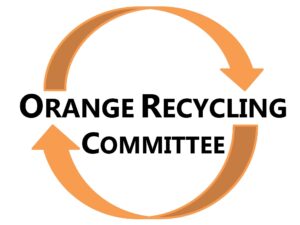By Susan Wineland
Orange Recycling Committee
 You put your recycling in the bin. You drop it at the curb or take it to your local drop-off. Then you wonder, is my paper actually getting recycled?
You put your recycling in the bin. You drop it at the curb or take it to your local drop-off. Then you wonder, is my paper actually getting recycled?
Yes. Recycled paper is used to make many new products such as paper bags, toilet paper, computer paper and all different kinds of boxes. Lots of paper products can be recycled. Examples include the box your cereal or toothpaste came in, bakery boxes for donuts, computer paper, white office paper, newspaper, colored office paper, chipboard, magazines, catalogs, phone books, and powdered laundry, dishwasher and detergent boxes. Corrugated cardboard and boxes can be recycled in your blue bin and also taken to the cardboard hopper at the Orange Transfer Station, where the cardboard is purchased by a local paper processing business.
As with all recycling, it’s important to make sure that the items are clean and dry and don’t have any contaminants mixed in, such as polystyrene, metal, wax, plastic coatings and other debris which should go in the trash. Pizza boxes can be recycled, but take out the paper liner and any residual food. Flatten boxes before putting them in the recycling bin and remove cereal bag liners. Not allowed is anything smaller than four by four inches or shredded paper.
If you need to shred personal documents, Affordable Solutions based in Orange provides shredding services at many local town events such as the semi-annual Orange Shredding Day. The shredded paper then goes to a local paper broker who is equipped with facilities to sort, bale, and transport paper.
Brokers play an important role in connecting suppliers with mills, arranging transportation and facilitating transactions. This way, businesses can streamline their recycling processes and contribute to a more sustainable paper recycling ecosystem.
About 80 percent of US paper mills use some recycled paper to make new and innovative products. When paper goes to a paper mill, the process begins at any number of locations, including community curbside programs, drop-off centers, schools or offices. We fill the recycling bin with accepted materials, the paper is collected and goes to a materials recovery facility. It’s loaded on a conveyor belt and contaminants are removed. Next, the recovered paper is separated, baled then transported to a paper mill where the paper bale is loaded into a pulper, which looks like a giant blender. The paper is mixed with water and other ingredients, then churned and broken down. Contaminants such as tape, labels and staples are screened out. From there, this slurry of fibers is screened for further cleaning. As it dries, it is formed into rolls of paper – newly recycled paper.
Connecticut is home to various wastepaper processors and brokers equipped with facilities to sort, bale and transport paper. These entities play a pivotal role in connecting suppliers with mills, arranging transportation and facilitating transactions. By working with reputable processors and brokers, businesses can streamline their recycling processes and contribute to a more sustainable paper recycling ecosystem.
The importance of recycling paper can’t be overstated. Paper constitutes the largest single component of the municipal solid waste stream – over one third by weight.
By recycling the paper into new paper, rather than disposing it, the amount of waste requiring disposal will be reduced, fewer trees will be cut down for paper production, less energy will be used to produce new paper, less pollution will be emitted into the air and water in the production of new paper and greenhouse gas emissions will be reduced. By purchasing more products in boxes, you can be assured that, once empty, that paper can be recycled. You’ll also be supporting our local paper processors and mills that recycle and then sell the new paper produced in Connecticut. Promote environmental sustainability and local and state businesses at the same time.
Susan Wineland is a member of the Orange Recycling Committee.